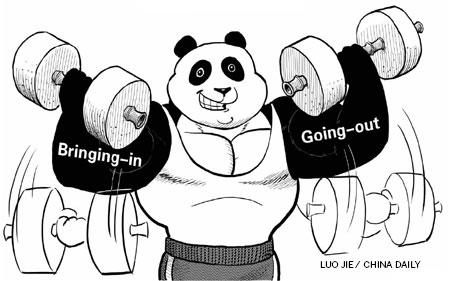
For years, Chinese people and experts on China have known well the official line of "further opening-up". Now they might as well get used to the subtle but distinct change in its wording, as the Communist Party of China and the government have in recent years repeatedly pledged to build an open economy.

The Communique and the Decision on Major Issues Concerning Comprehensively Deepening Reforms, issued at the end of the Third Plenary Session of the 18th CPC Central Committee, reiterate that China would develop a new open economic system, adapt to the trends of globalization and better combine "bringing-in" and "going-out" investment approaches.
The most important way of implementing the reform and opening-up policy is not to draft a huge list of measures, but to clearly define the fundamental goal and basic guidelines. On one hand, China will intensify the opening-up drive to invigorate its social and economic systems, and realize sustainable economic and social development. On the other, China intends to, through further opening-up, make full use of the external resources to better position itself in the global division of labor and on the international profit ladder.
Since furthering of the opening-up drive is not an end but a means toward the pursuit of national interests, China must have the final say on issues such as the order of and extent to which relevant areas will be opened up further, and whether there are prerequisites for doing so. This point can never be over-emphasized because, in practice, many people mistake the opening-up drive as an end in itself and thus fail to see the importance of the pursuit of national interests.
The substance of the opening-up drive can never remain unchanged. Reform and opening-up started in the coastal regions in the late 1970s, and mainly involved commodity trading and direct investment. Today, reform and opening-up cover the entire country, and the focus of further opening-up will gradually shift to the service sector, and direct and portfolio investments in high-end manufacturing.
The country remains committed to opening its market wider to the outside world, but now it is in growing need of wider access to the markets of its trading partners.
China embarked on the course of reform and opening-up in 1978. In the initial stages of opening-up, China's foreign trade was small, although the overseas market was still open and vast enough to accommodate the growth of its foreign trade. Except for the companies set up in Hong Kong and Macao to attract foreign investment and establish overseas contacts, the overseas direct investment on the Chinese mainland was not large enough to demand diplomatic efforts to persuade its trading partners to open their markets wider to China-made products and Chinese investment.
In terms of "bringing-in", China had only a limited volume of import and foreign capital inflow, and thus the side effects of opening up its commodity and investment markets were not that visible - or were simply downplayed because of the given advantages. After all, what China needed most was foreign investment to fill the gap in capital and foreign exchange reserves, as well as advanced technologies and equipment to upgrade the domestic industrial system. In the interim period, it needed to import some newly upgraded goods to prepare for the potential explosion in domestic consumption in the future.
However, after more than 30 years of reform and opening-up, China has accumulated enough capital to meet its development needs, and the gap in its foreign exchange reserves has become history. In particular, in the 10-plus years since its entry into the World Trade Organization, China's economy has become highly dependent on trade; China is even said to be the largest beneficiary of globalization since the 1990s.
The side effects of unilaterally opening up China's commodity and investment markets are getting obvious, with the marginal gains from the opening-up drive sloping downward while the marginal costs keep rising. China's economic interests abroad have increased manyfold, with massive investment in a wide range of areas, including raw materials and energy. But many of its trading partners are now resorting to trade protectionism and imposing a ceiling on the entry of China-made products and Chinese investment into their markets.
If China intends to maintain its competitive edge across the world, it is advised not to open its markets wider to the outside world without asking its trading partners to open up their procurement, sales and investment sectors to China. In this sense, the new wording of "building an open economy", indicative of China's consistent pledge to open up its market to the outside world and its goal of getting wider access to the global market, reflects initiatives that may lead to substantial changes.
The author is a researcher at the International Trade and Economic Cooperation Institute, affiliated to the Ministry of Commerce.
Copyright ©1999-2018
Chinanews.com. All rights reserved.
Reproduction in whole or in part without permission is prohibited.